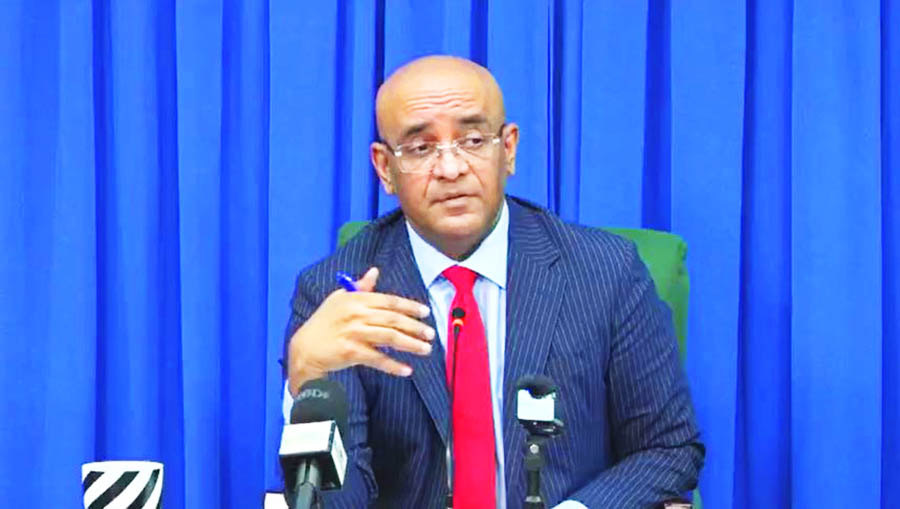By Antonio Dey
Vice President Bharrat Jagdeo yesterday said that 238 out of 242 Indigenous communities have so far been assigned the sum of $4.7 billion from Hess Corporation for the sale of carbon credits from Guyana’s rainforests.
According Jagdeo, based on feedback from village leaders at the ongoing National Toshaos Conference which is being held at the Arthur Chung Conference Centre, the funds are enabling the transformation of several communities. He added that of the $4.7 billion, some $2.6 billion has already been drawn down and by the end of this year, most of it will be expended.
“If you listen to the toshaos, you will hear how transformative these funds have been in their communities, which means there is progress.” Jagdeo told journalists at the Office of the President. He vowed that by next year, these communities will get more funds to continue the ongoing transformative work. The remaining four communities are expected to complete the process outlined by the government before the monies set aside for them can be released.
Requirements to use the funds include the submission of a plan for utilisation, along with the minutes of the meeting where the plan was discussed, submission of a sign-in sheet to show who attended the meeting and evidence that two-thirds of the village supported the plan, Jagdeo said.
Once the criteria have been completed and accepted, village heads are invited to sign a letter.
According to the Vice President, each community will be beneficiaries of funds ranging between $10 million and $35 million from the first set of carbon payments from Hess Corporation. It is unclear how it was decided how much each community receives.
He then accused the Amerindian Peoples Association (APA) of attempting to block funds from going to hinterland communities from the sale of carbon credits. The APA has denied this.
In April this year, the Stabroek News reported that the APA had lodged a formal complaint with Winrock Architecture for REDD+ (Reducing Emissions from Deforestation and forest Degradation) Transactions (ART) Secretariat. They contended that the principle of Free, Prior and Informed Consent (FPIC) was not applied to the issuance of carbon credits for the period 2016 and 2020.
The complaint was lodged after US oil company, Hess Corporation, purchased US$750 million worth of the jurisdictional carbon credits from Guyana in December. The first payment of US$75 million has already been issued to Guyana but the objection by the APA could potentially delay future payments.
In March this year , attorney-at-law, Melinda Janki, said that the government’s carbon credits arrangement with Hess Corporation violated the constitutional rights of Amerindians to their property and self-government.
Janki, in a letter to President Irfaan Ali, warned that any claim by his government purporting to have acquired the consent of the National Toshaos Council (NTC) to sell carbon credits, “is legally impossible.”
She told the Head of State that while it may be the intention of his government to respect and protect Amerindian rights, it appears to be unfortunately doing quite the opposite through the arrangement with Hess.
Wauna Village questions use of carbon credit monies
The Indigenous community of Wauna (Region One) was recently divided over how carbon credit monies have been used for the purchasing of wiring for an electrification project and the way forward is unclear.
Disagreement in the community has also raised early questions about accountability for monies under the Hess carbon credits programme – a portion of which is going to Indigenous villages.
Controversy surrounded the purchasing of the wire for electrification as the person who made the acquisition did so from a store which had not provided a quotation and questions have now arisen about the quality of the item.
In Wauna, the $18 million carbon credit grant was allocated to the Community Development Council (CDC), of which $13.8 million was set aside for the electrification project.
The project when completed will see the entire village supplied with electricity 24/7 from their main grid and it is among 27 projects that are set to be implemented in the community over the next ten years. The project includes wiring homes since most of the dwellings in the community lacked this.
A committee comprising members from different backgrounds including health and construction, was formed to oversee all the projects.
The villagers alleged that a CDC councillor, along with two businessmen, spent some $5 million to purchase the wiring to be used in the project. The villagers claim that the wires are faulty and too expensive with no proper bidding done for the project.
As such, the residents in an effort to have their voices heard, staged a demonstration in the village calling for transparency in the project. This sparked a protest on August 13, which then prompted a meeting with the Regional Chairman for Region One, Brentnol Ashley, at which villagers were able to voice their concerns.
Background
Back in December 2022, the Govern-ment of Guyana entered into an agreement with Hess Corporation for the sale of carbon credits for a minimum of US$750 million between 2022 and 2032. The first deposit of US$75 million represents: US$37.5 million for 2.5 million ART-TREES credits from 2016 at a price of US$15/tonne of Co2e; and US$37.5 million for 2.5 million ART-TREES credits from 2017 at a price of US$15/tonne of Co2e.
By the end of 2030, Guyana should amass at least US$750 million from the deal inked with Hess and 15% of the sum, or US$112 million overall, is expected to go directly towards Indigenous communities which is stipulated under Guyana’s Low Carbon Development Strategy (LCDS).
Apart from the Hess deal, Guyana still has 70% of its carbon credits available for marketing. And if the price for the credits is extrapolated, Jagdeo said Guyana could get approximately US$2.5 billion.
He reiterated that 85% of the sale of the carbon credits will go towards climate change adaptation.






